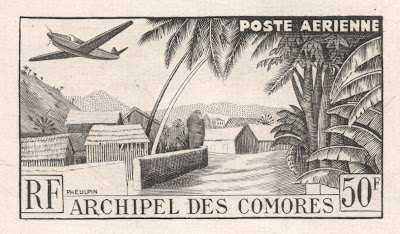Jean
Pheulpin (1907-1991) was born in Valentigney in the district of Doubs. His
father was an industrialist, but had the good sense to steer his son, who so
obviously was in love with all things beautiful, towards a proper education
where he could translate his love into a decent profession. And so, Pheulpin
was soon packed off to spend four years at Boulle, the College for Applied Arts
in Paris, where he worked with metal and learned the art of engraving.
Pheulpin
then spent five more years at the School of Arts in Paris. There he could
immerse himself completely in the world of engraving, taking lessons from the
engraver Antoine
Dezarrois, together with many other students who also went on to become
famous French engravers, such as Cheffer, Gandon and Piel.
Pheulpin’s
career started by teaching drawing at various schools in the Parisian suburbs.
He kept this up for many years, with his pupils always being delighted to tell
him of his latest stamps which were on show in the various stamp shop windows.
But meanwhile he also took on commissions for engravings for national museums
and for the bulletin issued by the Society of Bibliolatry.
After the Second World War, Pheulpin
submitted an essay of a portrait of Bossuet, to try and get a position as a
stamp engraver. The portrait was made in stamp vignette format and was of a
lovely finesse. The postal authorities liked his work and he was employed by
them. Pheulpin’s first stamp was engraved in 1949 and issued in 1950: the 50f
airmail value from the definitive set issued in the Comoro Islands. He also
designed it. His first stamp for France followed soon after, in 1951. It was a
single value issued for the Popular Pictorial Art Exhibition in Epinal. The
subject of the stamp was St. Nicolas.
Unlike many
other French engravers, Pheulpin kept on spending a large amount of time
working on stamps for the various French territories. His engravings for Laos,
in particular, are a major part of his portfolio. For nearly two decades, the
1950s and 1960s, the vast majority of stamps issued in Laos were engraved by
Pheulpin. During that time, he forged wonderfully creative partnerships with
the designers Marc Leguay and Chamnane Prisayane. One of highlights of
Pheulpin's Laos portfolio is without a doubt the 1954 set marking the Golden
Jubilee of King Sisavang Vong. The single design, showing various royal
buildings in the capital Vientiane, was used for three values, which have now
become the key items in any Laos collection.
But it was
Pheulpin's Laotian Elephants stamp set, issued in 1958, upon which most praise
was heaped. It became a well-known set because mint copies of the lower values
formed a standard part of any approval or stamp packet in the 1960s. It even
won Pheulpin the prestigious Grand Prix de l’Art Philatélique.
In an early interview, Pheulpin said
that he enjoyed engraving portraits and landscapes the most, although he did
admit having great trouble engraving a French stamp depicting Henri Poincaré,
issued as part of the National Relief Fund set of 1952. Poincaré was a typical
bourgeois man, clad in black with a monocle and a small bow tie. Not at all
interested in the image he would leave behind for posterity, Pheulpin had to
work hard to find a suitable way of portraying the man, discarding an initial
portrait-style stamp for one where he has Poincaré reading a book.
As much as
he loved it, Pheulpin did concede engraving was often very hard work: peering
constantly through microscopic magnifiers, creating lines which had to be fine,
compact and deep enough to be still visible after having been copied several
times; from master die to transfer roller, from roller to printing plate and
from plate to stamp paper. Time was another major aspect and Pheulpin is quoted
as having stated that he had to work 79 hours a week when completing his
engravings for the 1952 set to mark the admission of Laos into the UPU. Yet,
when asked whether he wasn’t afraid to damage his eyesight, he referred to a
professor at his former art school who was still engraving at the age of 93!
Though
Pheulpin did not quite make it to that same old age, he did in all engrave some
650 stamps, the last of which were issued just days after his
81st birthday in 1988, being a French Polynesian set on medicinal plants.
Jean
Pheulpin's database can be found HERE.




